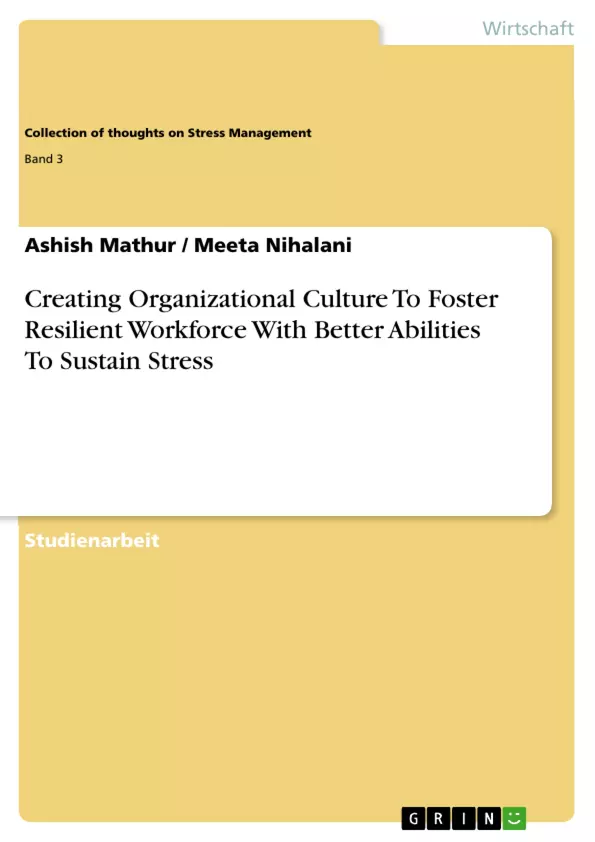The stress management is important for the companies because the modern work life has
exposed the employees to the various forces. The employees need to be healthy and
happy in order to build the culture of growth and productivity of the employees. The
organizational cultures are the expression of the management and the employees in form
of their faith and trust for each other’s. The employees need to be respected as they are
the basis of growth and development of the organization. The organizational culture is the
reflection of the work values I from security and reward given to the employees. The
employees are the assets from the organizations. Enlightened companies recognize the
importance of a healthy and satisfied workforce as a means of attracting and retaining
staff, and achieving enhanced performance through enabling them to withstand the
pressures associated with modern life.
Inhaltsverzeichnis
- 1,Introduction
- Culture
- 3,Key findings of the studies are outlined below:
- 4,Building Blocks for Managers to Create a Culture and Climate to Build a Resilient Workforce
- LITERATURE REVIEW
- 5
Zielsetzung und Themenschwerpunkte
Der Text befasst sich mit der Gestaltung einer Organisationskultur, die eine resiliente Belegschaft fördert und die Fähigkeit der Mitarbeiter stärkt, mit Stress umzugehen. Er analysiert die Faktoren, die zu Stress am Arbeitsplatz führen, und präsentiert Strategien, um eine gesunde und produktive Arbeitsumgebung zu schaffen.
- Die Bedeutung einer gesunden und zufriedenen Belegschaft für die Attraktivität und Bindung von Mitarbeitern
- Die Identifizierung und Analyse von Stressfaktoren am Arbeitsplatz
- Die Entwicklung von Strategien zur Förderung von Resilienz und Stressbewältigung
- Die Rolle der Organisationskultur bei der Gestaltung einer positiven und unterstützenden Arbeitsumgebung
- Die Bedeutung von Führungsqualitäten und Mitarbeiterentwicklung für die Förderung von Resilienz
Zusammenfassung der Kapitel
Das erste Kapitel führt in das Thema ein und beleuchtet die Bedeutung von Stressmanagement in modernen Arbeitsumgebungen. Es betont die Notwendigkeit, eine Kultur des Wachstums und der Produktivität zu fördern, die auf Respekt und Wertschätzung für die Mitarbeiter basiert. Das zweite Kapitel definiert den Begriff der Organisationskultur und identifiziert sechs Kategorien von "unerwünschten Arbeitsmerkmalen", die als potenzielle "Risikofaktoren" am Arbeitsplatz gelten. Es werden verschiedene Ansätze zur Gestaltung einer positiven Arbeitskultur vorgestellt, die auf die Bedürfnisse der Mitarbeiter ausgerichtet sind. Das dritte Kapitel präsentiert die wichtigsten Ergebnisse von Studien zum Thema Stress am Arbeitsplatz. Es werden Faktoren wie soziale Ungleichheit, Arbeitsanforderungen, soziale Unterstützung, das Verhältnis von Anstrengung und Belohnung, Arbeitsplatzunsicherheit, organisatorische Veränderungen und die Work-Life-Balance als Einflussfaktoren auf die mentale Gesundheit von Mitarbeitern untersucht. Das vierte Kapitel stellt konkrete Bausteine für Manager vor, um eine Kultur und ein Klima zu schaffen, das eine resiliente Belegschaft fördert. Es werden Themen wie soziale Unterstützung am Arbeitsplatz, Anstrengungs-Belohnungs-Balance, Arbeitsplatzabsicherung, organisatorische Veränderungen und Work-Life-Balance als wichtige Faktoren für die Förderung von Resilienz und Stressbewältigung hervorgehoben. Das fünfte Kapitel befasst sich mit den sichtbaren Auswirkungen von Stress und bietet Hinweise für Manager und Kollegen, um Stresssymptome bei Mitarbeitern zu erkennen.
Schlüsselwörter
Die Schlüsselwörter und Schwerpunktthemen des Textes umfassen Organisationskultur, Resilienz, Stressmanagement, Arbeitsumgebung, Mitarbeiterentwicklung, Führungsqualitäten, Work-Life-Balance, soziale Unterstützung, Anstrengungs-Belohnungs-Balance, Arbeitsplatzunsicherheit, organisatorische Veränderungen und Stresssymptome.
- Quote paper
- Dr. Ashish Mathur (Author), Dr. Meeta Nihalani (Author), 2011, Creating Organizational Culture To Foster Resilient Workforce With Better Abilities To Sustain Stress, Munich, GRIN Verlag, https://www.grin.com/document/184347



